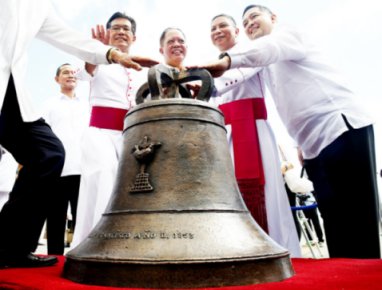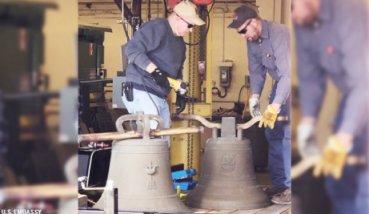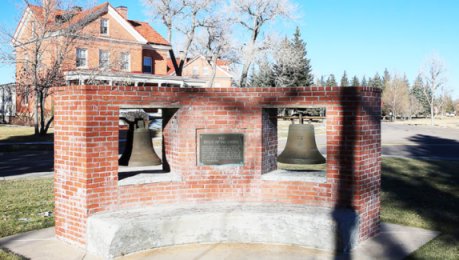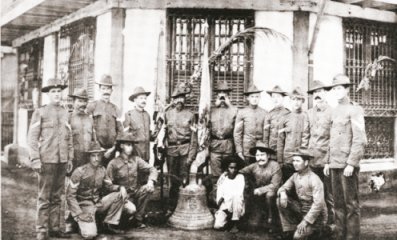
By: Veronica Leighton
After more than a century (117 years, to be exact) of wrangling for the return of the war trophy bells that the Americans seized from the Filipinos in Eastern Samar in 1901, after days of fierce fighting that resulted in 48 Americans armed with rifles and ammunitions and 2500 machete-wielding Filipinos killed.
History says that the pealing of the bells of Balangiga signaled an attack against the “foreign enemies” for the townspeople. Armed Filipino men (led by Valeriano Abanador), carrying machetes and disguised in women’s clothing went to the town church to peal the bells in rousing their comrades and townspeople and face the enemies, against the oppression of the foreign soldiers. The whole town was easily and eerily transformed into a town gravesite claiming a big victory for the Americans. We have seen a couple of moving Hollywood movies showing the Balangiga Massacre that really made us shed tears over the depiction of the fierce fighting of Filipinos versus American soldiers about this 1901 Massacre, following the 1898 U.S. takeover of the Philippines.
Thus the Three Bells of Balangiga were taken home by the American soldiers as a war trophy or booty with two on display at F.E. Warren Air Force Base in Cheyenne, Wyo., and the third was with the U.S. Army in South Korea.
On December 11, 2018, it was transported back to the Philippines, after decades of government negotiations and involvement of several past presidents of both countries.
Here is the timetable of its transport from U.S. to the Philippines, as history should be a matter of accuracy for our future generations … (From the Associated Press): The two bells left Cheyenne, Wyoming on November 15, aboard the American C-130 “Hercules” cargo aircraft and landed at Villamor Air Base, Pasay City around 10:30 a.m. after departing from Kadena Air Base in Okinawa, Japan. These were formally turned over on the same day to the Philippine government in a ceremony led by Philippine Defense Secretary Delfin Lorenzana, Philippine Ambassador to the United States Jose Manuel “Babe” Romualdez and U.S. Defense Secretary James Mattis. Romualdez said that the two bells were shipped to a facility in Philadelphia for restoration, before sending it to South Korea, where the third bell is located in a U.S. military museum.
At the handover ceremony, the bronze bells stood atop a red platform like silent symbols of a bygone era of hostilities, as American and Philippine flags flapped in the wind. Officials from both sides called for a minute of silence for the war dead. A military brass band played the “Lupang Hinirang” Philippine national anthem, followed by “The Star Spangled Banner.”
Prior to the turnover, the bells were inspected by the said officials along with Filipino and American military officers. The Balangiga Bells began the journey home to the local parish of Balangiga in Eastern Samar where it arrived Dec. 15, Defense spokesperson Arsenio Andolong said in a statement.
President Rodrigo Duterte resurrected a decades-old fight for the return of the Balangiga bells during his second State of the Nation Address in 2017. “Give us back those Balangiga bells. They are ours. They belong to the Philippines. They are part of our national heritage,” Duterte said in his speech.
Philippine Defense Secretary Delfin Lorenzana said at the tirnover ceremony that with the resolution of the issue, “It’s time for healing, it is time for closure, it is time to look ahead as two nations should with a shared history as allies.”
Although some U.S. officials earlier opposed plans to return the bells, the U.S. Department of Defense notified Congress as early as August 2018 that it intends to repatriate the bells.
The Balangiga Bells’ safe return is also thanks to the efforts of US Secretary of Defense James Mattis, supported by President Trump, and the U.S. Ambassador to the Philippines, Sung Kim.. “Citizens of the Philippines revere the bells as symbols of national pride. President Rodrigo Duterte repeatedly had called for their return. Good-hearted individuals and groups labored for decades to bring the bells home. Former presidents, Cabinet secretaries, Philippine and US ambassadors, historians, philanthropists and many others worked tirelessly to raise awareness of the history of the bells and to advocate for their dignified return,” Kim said.
The Trump administration agreed that bolstering the U.S. relationship with a key international ally outweighed concerns at home, even among Republican political allies.
From our home front, here in the Midwest, we would like to thank some public officials who also played an important role in the return of the Bells of Balangiga to the Philippines. First is Mayor Rita Gomez Sanders, a Filipino American Mayor of Bellevue, Nebraska, who was an inductee to the Chicago Filipino Asian American Hall of Fame 2017 for Public Service.
Says, Mayor Sanders, a member of the group that accompanied the return of the bells, “It’s very overwhelming. This is history, right? It’s a somber event for many. But it’s a joyful event for everyone in the Philippines.” She has family ties to the Philippines and whose efforts following a visit there last year helped get the bells returned.
Next is Rep. Don Bacon, R-Nebraska, who worked to include language authorizing the Pentagon to return the bells in last year’s defense authorization bill, and resisted Wyoming’s efforts to prevent it. Some veterans groups in Wyoming opposed returning the bells, considering them a war memorial to the 48 U.S. soldiers who were killed during a surprise attack on Sept. 28, 1901, in the Philippines city of Balangiga.
In a touching statement, Lorenzana asserted during the Balangiga Bells return ceremony, “After more than a century, the return of the bells to the Philippines from the United States now symbolizes the two countries’ “shared histories and ideals, new beginnings, renewed friendships and a stronger brotherhood.”
“These bells will be of joy, revelry and remembrance of shared history and ideals of the new beginnings, of renewed friendship and stronger bonds of two nations who have surmounted past challenges together and together are ready to face the future. Let the bells toll strong and loud for our countries,” he added.
Maligayang Pasko sa lahat! Mabuhay ang Pilipino at ang Pilipinas!

The return of Balangiga Bells in the Philippines, happily welcomed by priests and government dignitaries.


The 2 Balangiiga Bells displayed for decades leaving the American air base in Cheyenne, WY.

Old historic picture showing group of American military in Balangiga, Samar.

 VIA Times – December 2018 Issue Vital News, Vibrant VIews for Asian Americans in Chicago & Midwest
VIA Times – December 2018 Issue Vital News, Vibrant VIews for Asian Americans in Chicago & Midwest

